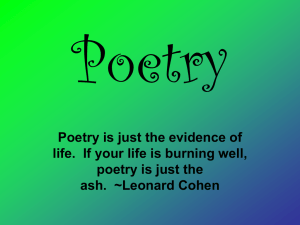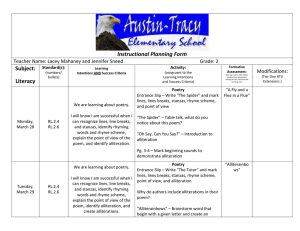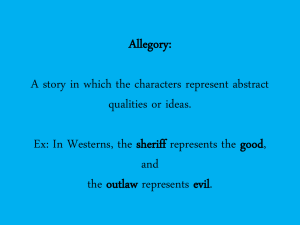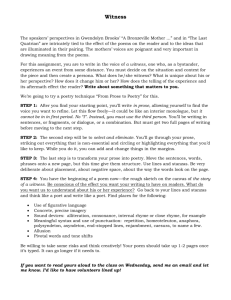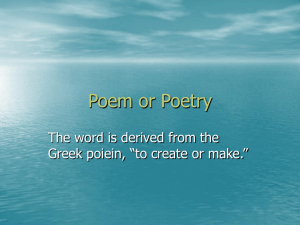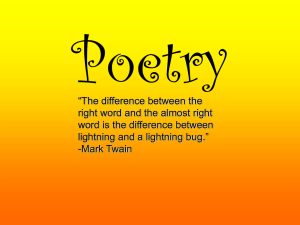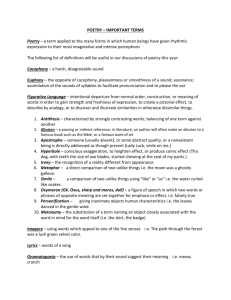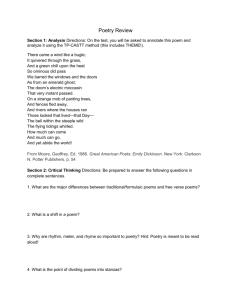File
advertisement
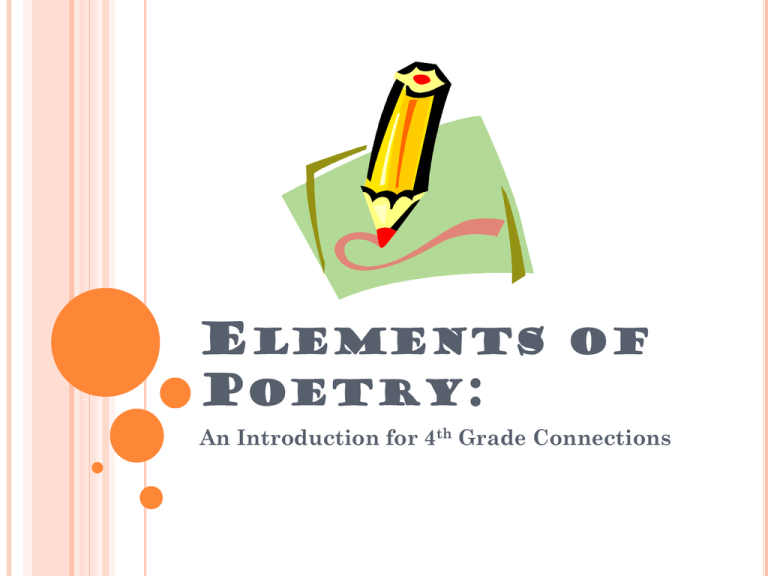
ELEMENTS OF POETRY: An Introduction for 4th Grade Connections LINES AND Lines STANZAS Stanzas Single lines in a poem. Several lines are organized into stanzas. 2 lines = Couplet 3 lines = Tercet 4 lines = Quatrain 5 lines = Cinquain 6 lines = Sestet 8 lines = Octet Stanzas usually express a unique idea, thought or image within a poem. They can be compared to a paragraph in prose. They are typically separated by a line break. e.g. of stanza (tercet): Do not go gentle into that good night, Old age should burn and rave at close of day; Rage, rage against the dying of the light --Dylan Thomas RHYME, RHYTHM Rhyme AND METER Rhythm and Meter Words at the end of several lines that have the same sound. Poems can have different rhyme patterns: John went to the park, A Where he found a shark. A He thought it was neat, B ‘Til it ate his feet. B Rhythm is the pattern of stressed and unstressed syllables in a poetry line. Meter is a specific rhythmic structure used in a poem. For example, a limerick has 3 lines with 3 stressed syllables (or beats) and 2 lines with 2 stressed syllables: There was an old man from Peru, If you happen to see A Who dreamt he was kissing his shoe. The watch I just lost, B He woke up at night, Please return to me. A With a terrible fright, Of course, at no cost. B To find it was perfectly true! ---Kathy Ewing LYRICAL POETRY Lyrical poetry usually follows a rhyme scheme Normally composed of stanzas and line breaks. Expresses emotional, personal feelings Example: Ah, when to the heart of man Was it ever less than treason To go with the drift of things, To yield with a grace to reason, And bow and accept at the end And end of a love or season? --Excerpt from Robert Frost, “Reluctance” FREE VERSE Free verse poetry does not follow specific rhyme or rhythm patterns. Some poets believe it allows them more opportunities to express themselves, because it is less structured. Free verse contains sounds that are more natural in everyday speech. Example: After the Sea-Ship—after the whistling winds; After the white-gray sails, taut to their spars and ropes, Below, a myriad, myriad waves, hastening, lifting up their necks, Tending in ceaseless flow toward the track of the ship: --Walt Whitman From “After the Sea-Ship” FIGURATIVE LANGUAGE AND OTHER TOOLS Poets often use figurative language and other literary tools to better express the ideas in their poems. These are a few: Imagery Personification Hyperbole Idioms Simile Symbolism Metaphor Mood Onomatopoeia Tone IMAGERY Imagery consists of words that create specific images and thoughts that appeal to all five senses. For example, the following excerpt from T.S. Eliot’s “Preludes” creates vivid images of a winter evening in the city: The winter evening settles down With smell of steaks in passageways. Six o'clock. The burnt-out ends of smoky days. And now a gusty shower wraps The grimy scraps Of withered leaves about your feet And newspapers from vacant lots; HYPERBOLE A hyperbole is an exaggeration of events and attributes in poetry and literature. The exaggeration serves to emphasize a point the poet wishes to make and is often humorous. Why does a boy who’s fast as a jet Take all day—and sometimes two— To get to school? —John Ciardi, "Speed Adjustments” SIMILE A simile compares two unlike things using words such as “like” or “as”. It is also used to create imagery and help the reader understand the poet’s vision. O my Luve's like a red, red rose, That's newly sprung in June: O my Luve's like the melodie, That's sweetly play'd in tune. ---from Robert Burns, “Red Red Rose” METAPHOR Metaphors are more direct comparisons. They do not use word such as “like” or “as” to create an image. I'm a riddle in nine syllables, An elephant, a ponderous house, A melon strolling on two tendrils. O red fruit, ivory, fine timbers! This loaf's big with its yeasty rising. Money's new-minted in this fat purse. I'm a means, a stage, a cow in calf. I've eaten a bag of green apples, Boarded the train there's no getting off. --Sylvia Plath, “Metaphors” ONOMATOPOEIA Onomatopoeia are words that sound like the noises they represent. Onomatopoeia can have a powerful impact on the reader. The squalling cat and the squeaking mouse, The howling dog by the door of the house, The bat that lies in bed at noon, All love to be out by the light of the moon. --From Robert Lewis Stevenson, “The Moon” PERSONIFICATION Personification is a figure of speech that gives human qualities to animals and inanimate objects. It can provide a fresh perspective when describing an event. I like to see it lap the miles, And lick the valleys up, And stop to feed itself at tanks; And then, prodigious, step. --From Emily Dickinson, “The Train” IDIOMS Idioms are popular phrases that do no literally mean what they say, but are meant to express an idea or feeling. They are usually humorous, and often contain similes and metaphors. Let the cat out of the bag Pulling my leg Hit the sack Feel like a million dollars Spill the beans Early bird catches the worm Smell a rat Jump the gun SYMBOLISM Symbols are words or images that stand for something else. Poets use symbolism in their work to suggest a greater meaning. They can be very powerful and memorable. For example, in Walt Whitman’s “O Captain! My Captain!”, the fearful trip refers to the Civil War, the ship symbolizes the United States, and the Captain is Abraham Lincoln. O Captain! my Captain! our fearful trip is done; The ship has weathered every rack, the prize we sought is won; The port is near, the bells I hear, the people all exulting, While follow eyes the steady keel, the vessel grim and daring: MOOD AND Mood TONE Tone The mood of a poem expresses an overall state of mind, or feeling. Some words that can describe mood are: The tone of the poem expresses the attitude of its speaker. Some words that can describe tone are: imaginary, idealistic, romantic, realistic, optimistic, pessimistic, gloomy, mournful sorrowful, etc. formal, informal, serious, humorous, angry, playful, neutral, sad, resigned, cheerful, ironic, clear, suspicious, witty, etc. AND, ONE LAST THING… Remember, the most important rules of poetry are: Be creative… Be original… Be yourself… …and have FUN!

